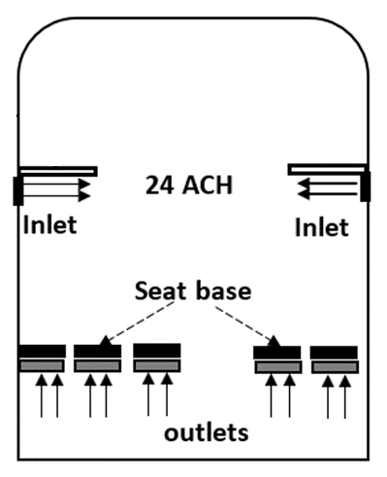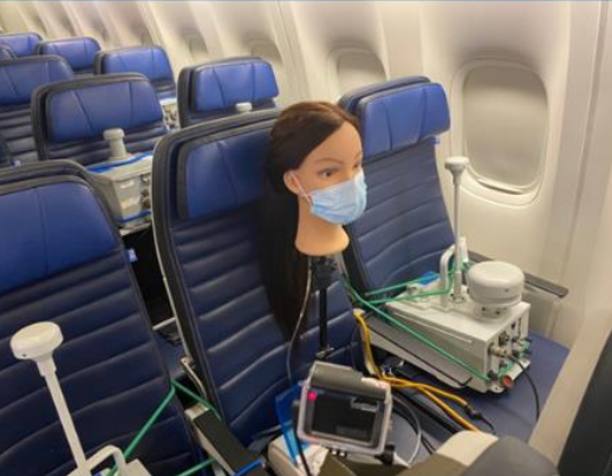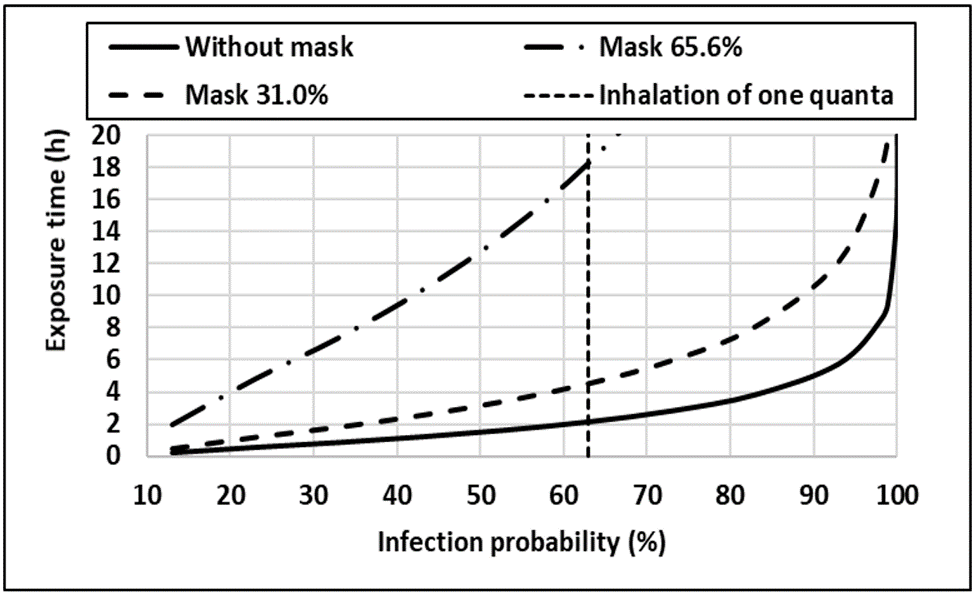A Framework for Modelling Dynamic Covid-19 Aerosol Dispersion and Infection Risk within the Built Environment and Transportation
FSEG responded to the COVID19 pandemic by adapting SMARTFIRE to simulate respired aerosol dispersion; and the EXODUS evacuation model to simulate physical distancing during pedestrian circulation.
The Problem
- The rapid emergence and global spread of SARS-CoV-2, and evolution of more transmissible variants, has led to a lack of quantitative understanding about precise mechanisms of transmission, viral loads and infectious doses.
- Assessment of Infection Risk and evaluation of mitigations such as air conditioning & filtration, physical distancing, mask wearing, etc., requires models capable of tracking the release and dispersal of infectious respired droplets and then predicting the risk of infection in an exposed population.
- Traditional approaches to evaluate Infection Risk often rely on “well mixed”, or steady-state, assumptions or may use sophisticated modelling tools in artificially static ways that can be unrepresentative of physical reality.
- Real world scenarios are influenced by many factors, including: perturbations caused by dynamic wake flows from people motion; state of health and movement of people; and degree of immunity in “susceptible” population – which changes over time due to vaccinations or prior infection and the prevalence of more/less infectious variants.
A Covid-19 Modelling Framework
The key features of the novel modelling framework are based on
integrating and merging a set of new modelling capabilities with a number of
existing modelling capabilities that were modified and enhanced to address
the new Covid-19 aerosol dispersion application area. These included:
New Modelling Capabilities:
- Respired droplet release model providing appropriate characterisation of droplet size distribution and suitable expired breath airflow for an infected person (e.g., when breathing, talking, coughing, etc.);
- Ability to evaluate absolute risk of infection based on exposure to aerosol droplets at a target volume of interest using a Wells-Riley approach;
- Support for moving sources i.e., walking sources (infected or “index” patients);
- Support for stationary or moving targets (i.e., susceptible people);
- The impact of wake flows generated by occupants walking through the droplet dispersal tracking field, using the immersed boundary method;
- RNG turbulence model to improve flow modelling accuracy;
- Support for air conditioning modelling capabilities to allow the re-circulation and re-distribution of droplets with the possibility of droplet culling due to filtration effects (e.g. ordinary or HEPA based filters) whilst also allowing the arbitrary configuration of the proportion of fresh and recycled air.
Modified Existing Capabilities:
- Aerosol droplet tracking using Lagrangian particle tracking;
- Droplet evaporation, that is sensitive to humidity and temperature, with droplet size reduction to “fate” nuclei/fomites with history of original number of likely virions released in each droplet to allow infection risk to be deduced from exposure to multiple droplets at arbitrary times since exhaled;
- Droplet surface deposition, accumulation and persistence;
- New flow pattern definition over the cross section of an inlet.
Adopted Approach using Localised Wells-Riley with CFD Modelling
FSEG implemented a localised form of the Wells-Riley model in SMARTFIRE[1] using a “quanta” based release allowing calibration of the many unknowns of Infection Risk against known infection events.
 Basic Wells-Riley Equation for Probability of Infection, where D is dose
of infectious agent.
Basic Wells-Riley Equation for Probability of Infection, where D is dose
of infectious agent.
- The CFD model represents respired aerosol droplets using either a scalar tracer gas transport model or an adapted water mist/droplet dispersal model to release/track the droplets (sizes from <1 µm to >100 µm dia.)
- Modelled droplets are carried-by and react-to local environment air flows, so temperatures and droplet sizes change due to evaporation. Droplets, composed of respired fluids, attain a fated size due to solids concentration. Infection Risk is evaluated from droplet residence times in static or dynamically moving sampling regions.
- Approach also considers dynamics of human behaviour allowing index patient(s) and susceptibles to move and cause wake flows. This greatly enhances the sophistication of possible modelling scenarios and gives better physical agreement with the real-world situation.
- Confidence is gained simulating dispersal events and experiments in challenging ventilation scenarios (e.g. trains – Infection Risk from statistical analysis of actual Covid-19 infections; aircraft – Infection Risk from experimental particle dispersion tracking), showing similar Infection Risks, trends and conclusions.
Chinese G-Train Infection Risk Modelling
Chinese (long dist.) G-Trains have several ventilation strategies and large airflow rates.
 |
 |
| Seat Layout in Standard Class G Train Carriage | Example Ventilation Strategy |
Statistical analysis[2] considered reported infections from many passenger-journeys during the early stages of the pandemic. This allowed evaluation of Infection Risk due to proximity to an index patient in various types of carriage.
 CFD Transport Equation for a Scalar
Concentration.
CFD Transport Equation for a Scalar
Concentration.

- CFD analysis of Infection Risk at a seat location of interest, using a scalar dispersal in the carriage ventilation flows, shows good agreement with trends derived from statistical analysis.
- CFD analysis, being sensitive to local airflows of complex environments and their interaction with body-heat thermal plumes, provides an understanding of why certain locations have higher Infection Risk and how ventilation strategy affects this. Such nuanced analysis is not possible with simple “well mixed” assumptions that are invalid for complex train carriage air flows.
- Analysis was extended to evaluate the impact of mask wearing, demonstrating that, if 90% of passengers wear high efficiency (N95) masks, overall Infection Risk reduces by 95%.
Inflight Transmission of COVID-19 Based on Aerosol Dispersion Data
FSEG have published an article [3] in Journal of Travel Medicine, exploring the relationship between exposure time and Infection Risk, based on Boeing aircraft experimental aerosol dispersion data.
 |
 |
| Aircraft Aerosol Dispersion Experimental Trial | Aircraft Infection Probability with Usage of Face Masks |
Summary of FSEG’s conclusions from this Research:
- Time to infection is unrepresentative (and unhelpful) in considering Infection Risk.
- Long flights (12 hours) can have maximum Infection Risk of 99.6% and average Infection Risk of 10.8%.
- Efficient masks can reduce Infection Risk by 86%.
Modelling the Dynamics and Impact of People Movement
Although static/steady-state models can be helpful, the real world is often more complex with transient perturbations. FSEG is developing dynamic modelling capabilities to allow these complexities to be included in Infection Risk analysis.
People following through first walker’s respired aerosol cloud (with wake flows).
Airborne droplets from infected person (mobile source) in air-conditioned supermarket.
FSEG have also modelled the dynamics of an infected person walking through, and releasing aerosol droplets in, a ventilated supermarket. This highlights the impact of low ACH ventilation rates that allow the respired aerosol droplet cloud to persist for a considerable time and, potentially, infect others. Droplets can evaporate, deposit on surfaces or deactivate (over time).
Key Observations
- Infection risk cannot be explained only by large droplets and fomites. This has been observed at quarantine hotels where shared air conditioning has resulted in remote infections.
- Mask wearing gives significant benefits in reduction of Infection Risk.
- High ACH rates give better aerosol clearance, but can cause local recirculation or air flow paths that actually promote increases in Infection Risk.
- Dispersion and perturbations, due to people movement, can be significant.
Challenges During the Project
- The air conditioning recirculation capability presented challenges for the modelling that have required novel solutions to linked boundary conditions to represent the way that air conditioning may remove air at one or more physical locations in a room and re-introduce the recirculated air at another location – which is especially applicable to passenger trains and aircraft, where passengers may be exposed to the enclosed environment for a considerable period of time and to partially recirculated air containing infectious droplets and nuclei. Droplet culling and distribution over an outlet (source) had to be resolved for a variety of use cases where the “behind the scenes” air conditioning airflows are complex and cannot be modelled.
- One issue that arose was related to the handling of very fast evaporation of small droplets from respiration. The numerical solver became extremely slow, to the point of becoming practically unusable, as it attempted to accurately model this phenomenon. Previously (when solving purely water mist problems) droplets below a certain % of their original size were simply removed from consideration by the simulation as their tiny volumes of water would provide little contribution to suppressing a fire. Such an approach is not possible with covid particles as the number of infectious virions in a droplet needs to persist even as the droplet evaporates to a solid tiny nuclei. Once the problem was identified, for the smaller droplets, it was assumed appropriate to model them such that they would instantaneously reach equilibrium diameter. This was found to be a good approximation as evaporation time was typically less than 1s and was of the order of 10s.
- A further challenge has been the lack of available data for validation studies concerning indoor spread of COVID-19. The team have adapted to the available resources covering droplet dispersal of aircraft and trains, as well as investigations of superspreading events. Even with these resources, there are, and have been, significant modelling challenges due to a lack of information about ventilation characteristics and unknowns about the respired aerosol generations rates, droplet infectivity and susceptibility of people and changes due to mutations/variants and evolving state of population vaccination/natural immunity that make it difficult to determine representative quanta generation rates. Approaches have been adopted to address these challenges and the flexibility of the modelling approach shows the validity of the core modelling assumptions. It is also challenging to find validation examples that have moving droplet sources and targets. This is quite typical of advanced modelling techniques and has been addressed by using validation scenarios that are more typical of the generally available modelling capabilities in this application area.
Other Developments
Most capabilities developed/validated in isolation. FSEG are testing full
integration and investigating significant multi-featured and complex
scenarios.
Link with agent-based simulation software EXODUS, enabling movement of
agents attempting to maintain physical distancing, to move sources and
targets for dynamic infection risk analysis in realistic circulation
scenarios.
EXODUS modelling movement (faster than actual) of agents attempting to maintain physical distancing.
FSEG are continuing to research and develop additional capabilities to support the Covid-19 aerosol dispersion modelling capabilities. This includes the development of User Interface capabilities to allow easier generation and configuration of scenarios and an unstructured meshing approach to support some of the complex geometries that can be found in modern buildings and in the fine details of ventilation handling.
Related Work and Links
Presentation (FSEG COVID19 Mitigation Analysis using CFD and Agent Based Models) describing FSEG CFD model developments relating to dispersion of respiratory aerosols and COVID19 and applications to transport systems at the RAMP conference, ‘New Models of Spatial and Social Behaviour in a Pandemic’ held at Cambridge University, 26-27 May 2021,
Presentation (FSEG COVID19 Mitigation Analysis – Harnessing CFD Fire Simulation And Agent Based Models), describing FSEG agent based and CFD model developments associated with COVID19, presented at the Isaac Newton Institute For Mathematical Sciences, Cambridge University, Infectious Dynamics Of Pandemics (IDP): Mathematical And Statistical Challenges In Understanding The Dynamics Of Infectious Disease, Seminar, Afternoon Session, 14/07/20. Presentation Starts At 01:31:41 Into Video.
Other outreach and promotion activities have used the project work to
target diverse audiences on platforms such as LinkedIn, e.g.:
https://www.linkedin.com/pulse/uninvited-guest-christmas-table-could-infect-two-loved-ed-galea/
https://www.linkedin.com/pulse/fseg-covid-19-mitigation-analysis-harnessing-cfd-fire-ed-galea/
Referenced Work
[1] Z Wang, F Jia, E R Galea, and J H Choi, (2017), “A forensic
analysis of a fatal fire in an indoor shooting range using coupled fire and
evacuation modelling tools”, Fire Safety Journal,
http://doi.org/10.1016/j.firesaf.2017.03.029
[2] Hu et al., "The risk of COVID-19 transmission in train passengers:
an epidemiological and modelling study," Clinical Infectious Diseases, no.
https://doi.org/10.1093/cid/ciaa1057, 2020
[3] Z Wang, E R Galea, A Grandison, J Ewer, F Jia, “Inflight
Transmission of COVID-19 Based on Experimental Aerosol Dispersion Data”,
Journal of Travel Medicine, 2021; https://doi.org/10.1093/jtm/taab023
Acknowledgement
University of Greenwich Innovation Fund – Proof of Concept Development
Award

